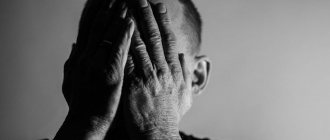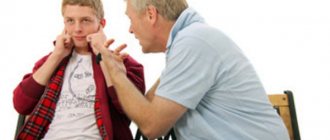Self-injurious behavior is the deliberate infliction of injury to one's body for internal reasons without suicidal tendencies. Self-harm is a symptom of many mental illnesses. A common form of self-injurious behavior is cutting and scratching the skin with sharp objects. Other forms of auto-aggressive actions include burning the skin, consuming toxic substances, striking various parts of the body, pinching the skin, pulling out hair, and preventing wounds from healing.
Behaviors associated with substance abuse and eating disorders are not considered self-injurious behaviors because the adverse events involving tissue damage do not occur intentionally in the described case. Despite the fact that suicide is not a desire to harm one's body, there is a connection between self-harmful behavior and suicide, since causing injury can be a high risk of danger to life.
What is self-harmful behavior
So what is self-harm? There are several definitions, here are some of them:
Self-harm is the intentional infliction of bodily harm for internal reasons without suicidal intent. It is a behavior that combines acts of violence against the body and hidden ways of harming oneself, regulated by unconscious processes and associated with insufficient care of oneself and one's body. Self-harm includes actions indirectly aimed at self-destruction (including hidden forms associated with avoiding danger, increasing risk, seeking extreme experiences, or avoiding depression).
Self-harmful behavior occurs across different age and social groups. These can be both children and adults, men and women, single people and people from wealthy families, unemployed and successful in business, emotional and outwardly calm. Perhaps they all have only one thing in common: the inability to talk about their feelings and experiences or the reluctance to talk about it for fear of being misunderstood.
The highest level of auto-aggressive behavior is observed in adolescence from 10 to 24 years. The peak falls on girls 13-16 years old, boys 12-18 years old. Experts explain the increase in manifestations of this type of behavior by the specific growth of modern adolescents, due to the intensive development and influence of information and communication technologies, and increased public interest in forms of culturally sanctioned risky behavior.
Causes of pathomymia
The main character traits predisposing to the occurrence of this disease are:
- infantilism;
- high emotional sensitivity;
- imbalance;
- low self-esteem;
- anxiety;
- spiritual emptiness and lack of joy;
- tendency to aggression and self-injury.
Treatment of pathomymia requires identification of the cause of its occurrence. And the effectiveness of therapy in our clinic is achieved through the integrated use of all possible techniques.
Concomitant diseases
Patomimia is often observed with the following deviations:
- Psychogenic disorders. The cause is post-traumatic disorder, deep depression, some types of neuroses, including obsessive-compulsive disorder. By harming himself, the patient tries to switch attention from internal experiences to external sensations.
- Personality disorder. Any form of psychopathy is accompanied by a lack of self-control and self-criticism. Patomimia in this form of the disease is marked by severe impulsivity and constant severe anxiety.
- Hysteria. A person with such a deviation obviously or unconsciously wants to attract attention to himself or relieve internal tension. And one of these ways is self-harm. As a result, when pain occurs, it receives hidden benefits in the form of increased attention and other conditions.
- Organic diseases affecting the central nervous system. Pathomimia accompanies neuroinfection. It may also be a manifestation of complications after a stroke or head injury. In this case, aggression towards oneself takes on very cruel and rude forms, is temporarily controlled with the help of medications and completely disappears only after the root cause is eliminated.
- Schizophrenia. It can manifest itself in various forms of pathomimia, sometimes causing significant and disfiguring damage to the patient. Factitious dermatosis can be caused by delusions and resulting hallucinations. For example, a person thinks that worms are crawling under his skin and tries to remove them from there.
- Alcohol and drug addiction.
- Endocrine disorders and genetic predisposition.
- Autism, mental retardation, other types of mental retardation.
Some describe self-harm as a way to:
- express what is difficult to express in words,
- bring some feelings and thoughts into reality,
- make emotional pain physical,
- get rid of unbearable experiences and thoughts,
- regain a sense of control,
- get away from traumatic memories,
- there is something in life that you can rely on,
- punish yourself - for inappropriate behavior, feelings or thoughts,
- stop feeling numb, detached and disconnected from reality,
- create a reason to take care of yourself and your body,
- express suicidal thoughts and intentions without committing them.
While there are good reasons for self-harm, it is important to know that it is quite risky and dangerous. Once a person becomes addicted to it, it takes a lot of time and energy to stop.
What is parasuicidal behavior
Let's understand what parasuicidal behavior is. What are its reasons and what approach can a psychologist choose to help such a client.
In 1977, the term “parasuicide” appeared (Kreitman, 1977) meaning:
- behavior involving intentional, non-fatal injury that results in injury, illness or risk of death;
- any use of medications or other chemicals that are not prescribed for use or are used in high doses with the expressed intent of self-harm or suicide.
The emotional picture of people with parasuicidal traits is characterized by chronic emotional instability and negative self-views. Their behavior is characterized by hostility and irritability, which is why cases of depression and completed suicide are not uncommon. In relationships with others, such people are often demanding and conflictual, which makes them feel even more lonely, since they do not find support. Almost every such person will say that his main problem is difficulties in communicating with people. Often their thinking is black and white, so any difficulties take on a negative and tragic connotation. Such people do not know how to manage their emotional state and regulate it by cutting, damaging or using chemicals.
Self-harm and suicidal behavior in children
It is important to pay attention to the fact that SPP can manifest itself not only in children or adolescents, but also in a person of any age, gender, position in society, social affiliation. The damage can be done with or without suicide. In some cases, SPP is a symptom of a mental disorder that is important to treat and manage with the help of a psychiatrist.
Unfortunately, children and adolescents cannot always cope with difficult emotional experiences, especially if something painful happens in their childhood life (divorce of parents, death of loved ones, bullying, big quarrels with friends, etc.). Then some of them try to replace mental pain with physical pain.
It is important for parents to remember that self-harming behavior in a child is never normal. It requires attention, immediate response and correction, since there is a real threat to life and health.
There are various modern theories that try to explain the causes of SSP and suicidal behavior. One of these theories is the biopsychosocial model, according to which the occurrence of symptoms is always influenced by a combination of factors - biological, psychological and social at the same time. Therefore, in the treatment of such a problem there must be a combination of specialists working with human biology, his psyche and psychological state, as well as with the environment.
Suicidal behavior in children and adolescents
Some time ago, a special term “escape” appeared among teenagers, which can be translated into Russian as “death gracefully.” Press the button and exit the program, just like on a computer. The appearance of such slang expressions, as a rule, indicates the special relevance of the topic of life and death among modern teenagers.
In 80% of cases, a suicide attempt occurs at home and, as a rule, in the afternoon or evening. In most cases, suicide is a cry for help from loved ones. Surprisingly, teenagers decide to commit suicide, but at the same time they desperately want to contact family and friends at any cost to get support, help or express their disagreement with something.
Suicidal behavior, as a rule, rarely occurs immediately and impulsively. In order for a person to come to suicidal thoughts, much less switch to active actions, it takes time, as well as a deterioration in the internal state or external situation. Each of these stages can last from a few minutes to several months, and sometimes years.
The following stages of development of suicidal behavior are distinguished:
- Anti-vital experience. That is, a teenager can think or say out loud phrases, for example, “my life has lost its meaning,” “everything is bad,” “nobody needs me,” “nobody is interested in me,” “life as an existence,” and so on.
- Passive suicidal thoughts. The teenager has thoughts: “I want to fall asleep and never wake up,” “I want to be hit by a car,” “If I weren’t there...”, etc.
- Active suicidal thoughts. The teenager begins to become interested and seek information about methods of suicide, the process, the disadvantages and advantages of a particular method, etc.
- Suicide plans, formation of intentions. The teenager develops an action plan: determines the place, time and method. Searches for and prepares means for its implementation, and a decision on action is made.
- Suicide attempt. A teenager tries to commit suicide. It may or may not be complete, in which case the teenager may continue to try to change direction.
- Post-suicide.
The main causes of suicidal behavior include:
- protest,
- call,
- avoidance,
- self-punishment
- giving up life.
“Call” and “protest” among teenagers are the most common.
The most common causes of suicide among teenagers:
- loss of a loved one,
- chronic fatigue,
- low self-esteem,
- use of psychoactive substances.
What is the reason for this behavior?
Researchers have suggested (Thomas and Chess 1977, 1986) that a key source is a disabling childhood environment. This is an environment in which the feelings of a little person are not recognized, ignored or perceived sharply negatively by loved ones, often followed by punishment. Then the child perceives all his emotions and behavior as “wrong.”
At the same time, there are two significant features that form auto-aggression: the child is made to understand that he is mistaken in the description, reasons and analysis of his own experiences (“No, you’re angry, you just don’t want to admit it,” “You really should be ashamed of that.” , that you are offended by your mother (brother, sister)." Secondly, all violent emotional reactions of the child are regarded as “bad” behavior. Parents in such families do not know how to console, support, or reassure the child. This position resembles a situation when a drowning man must pull himself out by the hair, all he has to do is try, and he can do everything. If he couldn’t, it means he didn’t try. At the same time, individual skill and personal achievements are highly valued. Failure to meet these expectations leads to reproach, criticism and attempts to change the “inadequate” child's behavior.
The consequences of a child’s development in a disabling environment are manifested in the following :
- Without recognizing and ignoring the child’s feelings, the environment does not teach one to treat one’s experiences as a natural process characteristic of all people. Because the problems of an emotionally vulnerable child are not acknowledged, adults make no attempt to help him cope with them;
- By downplaying life's problems, adults do not teach them to endure difficulties and set realistic goals and expectations;
- In a family, extreme emotional experiences and manifestations are often necessary in order to evoke the desired reaction. The child constantly fluctuates on the verge of restraining emotions and displaying extremely vivid emotional states in order to attract attention.
- The child is not taught to trust his feelings; he is always looking for guidelines that will tell him how to think, feel and act.
In order to help a person with parasuicidal behavior, several areas need to be developed simultaneously. First of all, help you acquire the skill of getting in touch with your feelings, as well as develop the ability to manage them. There is an active focus on developing interpersonal effectiveness, self-control, and distress tolerance skills.
Symptoms of pathomimia
The clinical picture of this pathological manifestation is varied. Scratches, blisters, pustules, hemorrhages, and ulcers are found on the patient's skin. There is also a disturbance in the structure of hair and nails. During the initial examination, an inexperienced specialist may mistake manifestations of pathomymia for dermatosis. Therefore, you should pay attention to the features of the lesion:
- uniformity;
- predominance of minor elements;
- correct linear localization;
- damage in places accessible to the patient.
When a doctor recommends the use of local and general dermatological treatments, the effectiveness is low. The person's behavior disorder persists and this leads to new skin lesions. If, in the presence of a patient, a specialist expresses a hypothesis about the psychogenic origin of the pathology, he often receives a clearly negative reaction in response.
If treatment of pathomymia is carried out incorrectly, then in this case various complications are often observed:
- formation of purulent foci;
- formation of scar tissue;
- irreversible nail deformation;
- persistent alopecia (baldness).
Self-aggression will not be able to exhaust itself, it will intensify. The person begins to try to inflict even more severe physical pain on himself, and this ends in self-harm and even suicide attempts. Often self-torture goes hand in hand with paranoia, when a person insists on being cured of a problem, but at the same time categorically denies his participation in it.
Diagnostic criteria for pathomymia
- Uniformity and localization of damage.
- There are no symptoms characteristic of other dermatological diseases: peeling, rashes, focal hyperemia, etc. However, when an infection occurs, the formation of subcutaneous abscesses, acne, and furunculosis is possible.
- Lack of effect from previously prescribed treatment: despite the external agents used, antibiotics to stop the bacterial process, and physical procedures, skin lesions recur.
Doctors also pay attention to the patient’s behavior and communication style. Often, with pathomymia, a person reacts very sharply to any clarifying questions; the doctor’s attempts to collect a detailed history are perceived as mistrust and doubts about the listed complaints. He categorically rejects any hints about the psychological nature of the disease, disputes the research results indicating the absence of concomitant organic pathology, demands a more in-depth examination, and turns to other specialists. That is why, if there are signs indicating the development of pathomimia, a psychotherapist should first of all talk with the patient.
Types of pathomymia
This symptom is characterized by several variants of its manifestation. The most common forms:
- trichotillomania (pulling, curling of body hair);
- onychotillomania (damage to the nail plate using improvised means);
- onychophagia (nail biting);
- cheilophagia (constant lip biting);
- acne excoriation (damage due to skin inflammation);
- dermatolasia (provocation of skin irritation);
- dermatozoal delirium (scraping, frequent washing, treatment with products to eliminate an imaginary disease of the dermis).
Classification
In addition to “true” pathomymia, when the patient injures intact skin, the following types of disorder are distinguished:
- excoriated acne: self-harm of existing rashes: inflamed sebaceous glands and hair follicles, traumatic abrasions, insect bites, etc.;
- trichotillomania: independent pulling out of hair on the head or on other accessible and exposed parts of the body (eyebrows, eyelashes), can be combined with trichophagia - eating hair;
- onychotillomania: self-harm of the nail plates;
- Cheilophagia: licking and biting the red border of the lips.
How to help yourself overcome pathomimia
How can I help myself now?
When you have a strong desire to harm yourself, it is difficult for you to imagine that you can do anything right now.
But there are several ways to change or delay self-torture:
- understand patterns of self-harm,
- distract yourself from the desire to harm yourself,
- postpone your plan of action.
Try dividing your experiences into the following categories:
- Learn to recognize triggers. Triggers are what make you want to harm yourself. A trigger can be people, situations, feelings, certain thoughts and emotions.
- Try writing what happened immediately before the episode of self-torture: what thoughts did you have? Do your surroundings, people or objects, bring up unpleasant or difficult memories?
- Be aware of the desire to harm yourself. It can manifest itself through physical sensations:
- Rapid heartbeat or feeling of heaviness.
- Strong emotions such as sadness or anger.
- Feeling out of touch and numb.
- Repetitive thoughts.
- Unhealthy decisions, such as throwing yourself into work so you don't feel anything.
If you think these signs are a trigger for you, track them down and write them down - this will help you overcome self-harm when it comes up again.
Taking your mind off the urge to self-harm is a good way to give yourself more space and choice and reduce the urge to self-harm. You can be distracted both when the desire to harm yourself has just appeared, and when you are already in the process.
To understand patterns of self-harm, it is helpful to keep a diary and write down what happened before, during, and after each episode of SSP. To notice patterns, you will need to keep such records for some time, on average about a month.
But journaling can be frustrating. If you feel ready to try this technique yourself, be sure to do something nice and relaxing after recording. If this method is causing you pain, try asking someone you trust for support.
Distract yourself. This is the main self-help technique for SPP. Different people experience distractions differently, and each method may not work every time. For example, distracting from anger is not the same as distracting from fear, so it is better to use different strategies to be able to choose the right one in the moment.
Another way to counteract self-harm is to procrastinate: wait 5 minutes. It's not always easy, so if the urge to harm yourself persists, allow it to happen. If possible, increase the respite time and gradually create breaks between each act of HSE, for example, between cuts.
How can I help myself in the future?
Ultimately, you can help yourself by researching the causes of PSI. This will help you find other behaviors to replace the self-injurious ones.
Accept your emotions. If you've been ashamed of your feelings or have learned to suppress them for other reasons, getting in touch with them again will take courage. Difficult experiences can be very frightening, so it is important to take it very slowly and gradually. It may be worth using techniques such as mindfulness or journaling to support yourself and reduce the likelihood of emotional overwhelm.
- Try smartphone apps, online tools, books, and workbooks to address your emotions.
- Try working with a psychologist or psychotherapist you trust. You will have a positive experience of accepting and respecting your experiences.
- Try mindfulness techniques: Notice your feelings and name them as soon as you feel them.
Work with self-respect. Self-acceptance and a positive view of yourself can make a big difference in your life.
- Speak and think more kindly about yourself, as if you were talking about your loved one.
- Replace the urge to hurt yourself that pops up in your head with words that will empower you. For example: “Even if I want to cut myself, I will find another way to express how sad I am.”
- Regularly write down three things you value about yourself. It doesn't matter how small or insignificant they seem to you.
- Learn to calmly and confidently talk about your limits, to say “no” to what you think is inappropriate for you.
- Take control of your decisions. Remind yourself that you are responsible for your choices and choose something that aligns with how you feel about support and self-care.
Take care of your well-being and overall health.
- Keeping an eye on your health in all aspects will help you feel better.
- Regular exercise can improve your mood and reduce stress.
- A regular diet rich in fresh fruits and vegetables also affects our well-being.
- Making sure you get enough sleep will not only make you feel better, it will also make you more resilient to stress.
- Creativity helps you express your feelings: write songs, write stories, blog, draw, etc.
- Once a week, do something you enjoy: meet friends or go for a walk. Try to find time for yourself, even if your life is busy.
Try to understand your behavior more accurately. Getting rid of SPP can be difficult and time-consuming. It can be helpful to gain a deeper understanding of your relationship with yourself to prepare you for the big step. The more you understand why you self-harm, the better prepared you will be to make changes, find good alternatives, and learn what can support you in the process.
These questions will help you understand the origins of self-harm:
- How do you feel before and after your injury?
- How and why did you do this for the first time?
- What are the benefits of self-harm now?
- In what situations does SPP occur?
- What's scary in the future without self-torture?
- What effects might you have missed?
- What else can help us understand self-harm?
Ask for help. Asking for help can be very difficult, especially if you fear that others will judge or refuse to help. Remind yourself that everyone needs support sometimes, and it's okay to ask for help.
When you're ready, choose someone you trust and tell them how you feel. This could be a friend, family member, psychologist or doctor. Remember that only you decide what to say, and you don't have to say anything you're not yet ready to share.
It can be helpful to make a list of people, organizations, and websites that can help you find help in difficult situations. This will remind you that you are not alone and that help is available.
Unfortunately, there is no magic or quick way to stop self-harm, and change takes time and also involves setbacks. It is normal for the old behavior to temporarily take over after moving forward and making progress. If this happens to you, remind yourself that this is not a failure, but part of the process of getting rid of self-harm.
What help can I get?
Sometimes external support is required. You may need to try a few times to find what works for you and combine self-help techniques and professional support:
- therapist/psychotherapist,
- pharmacological treatment,
- support groups,
- online support community,
- scar treatment.
It takes courage and courage to ask for help. You may feel that you will not be understood or that you will be asked to make quick changes even if you are not ready for them. Such doubts are normal. But you have the right to support that will give you strength.
Any medical professional, your therapist or psychiatrist, psychotherapist, psychologist is obliged to discuss with you all possible treatment methods, your opinion and wishes must be taken into account.
How can friends and family help?
There is a lot you can do for someone suffering from self-harm. Your attitude is one of the main things that will help a person feel supported.
Here's what to remember:
- Try not to judge.
- Let him know that you are close.
- Remember that a person is more than his problem.
- Try to show empathy and understanding of the reasons for these actions.
- Allow the person to make their own decisions.
- Offer help and support.
- Remind the person of their strengths and what they are good at.
- Try to speak up and take responsibility for your fears.
What does not work?
Sometimes when we want to do our best, but it turns out just the opposite.
Here are some dangers to avoid:
- An attempt to help by force.
- Speak or act as if you are trying to control.
- Ignoring or focusing too much on damage.
- Definition of self-harm as "attention seeking."
Although in most cases, SPP can be a way to attract attention. If so, remember that it's completely normal to want attention, and that extreme stress can affect a person's ability to communicate directly what they need.
Clinical picture
As a rule, an act of auto-aggression is preceded by severe stress and emotional distress . A person begins to scratch either existing damage to the skin (for example, tear off dried areas of the epithelium) or injure completely healthy skin. Usually, easily accessible areas on the head, neck, arms, and chest “suffer.” The patient injures himself mechanically, with his nails or using various objects (scissors, nail clippers, etc.). Sometimes pathomimia is not limited to damage to the skin: the patient may bite or break off his nails, pull out his hair, etc.
Often the exacerbation of pathomimia is preceded by somatic and sensory manifestations:
- feeling of discomfort;
- itching, sore skin;
- tachycardia;
- dizziness caused by increased blood pressure;
- shortness of breath, etc.
Then comes a stage of temporary relief and satisfaction, but subsequently dissatisfaction with the condition of the skin increases. The patient seeks to disguise and hide scars, wounds and redness under clothes, applying foundation, etc.
Our guarantees
You can make an appointment by phone: +7 (495) 260-12-86.
When you turn to our specialists for help, you can be sure that this is:
- Anonymous: When registering, it is not necessary to indicate your real name, passport details or other personal information about yourself. All you have to do is provide a name under which the industry will contact you in the future.
- Confidential: Any information you provide to your consultant or other industry staff will remain within our practice. We do not share patient information with third parties. By contacting us, you can be sure of the complete security of the data you provide about yourself.
- Voluntary - While we understand the need to provide care to every patient we receive, we nevertheless reserve the right to stop working for you. You can always cancel your appointment or reschedule it for another day or time.
Professional treatment of pathomymia
Treatment of pathomymia is carried out comprehensively, for this purpose only conservative measures are used. This will require symptomatic therapy aimed at stopping the relapse. But the basis for providing assistance with such a deviation is the elimination of the cause of the disease, namely the mental deviation that leads to auto-aggression.
Usually in this case they use:
- psychotherapy;
- taking medications;
- local drugs;
- physiotherapy.
In the presence of self-destruction due to depression, neurosis or psychosis, outpatient treatment can be used. Severe disorders associated with schizophrenia or paranoid delusions require an initial hospital stay. This allows you to constantly monitor the patient’s condition and his reaction to the drugs used.
Psychotherapy for pathomymia
Since aggression towards oneself manifests itself due to a psychogenic disorder, the first place in providing assistance is given to the work of a psychologist. In this case, its goal is to restore a person’s inner balance and restore love for himself and his body. The following methods of psychotherapy are considered the most effective for this:
- analytical;
- cognitive-behavioural.
By analyzing the problem, a person is able to identify moments of self-harm when he does not consciously register them. The doctor helps to identify and eliminate the root causes of internal conflict and replace actions that are dangerous to health with safe ones. At the same time, the patient acquires self-control and relaxation skills.
If his incision is accompanied by increased tension, and the obsessive action allows him to calm down for a while, then in this case it is better to use cognitive behavioral therapy. An explanatory conversation is held with the patient about the origin of his illness, the destructiveness of such behavior, and he is taught a normal reaction to irritating factors and events.
Use of medications and ointments
In severe forms of mental disorders, it is recommended to select drug therapy after the patient is hospitalized. In case of insanity or inability to care for oneself, therapy can be prescribed without his consent, but only after consultation with a doctor. To alleviate conditions that cause autoaggression, it is recommended to use the following groups of drugs:
- anxiolytics;
- sedatives;
- neuroleptics;
- tranquilizers;
- antidepressants.
The prescription of each drug and the duration of its use is controlled by a doctor. At the same time, topical agents are used to promote tissue healing and prevent infection. First of all, this problem is solved:
- aniline dyes;
- solutions with antiseptic properties;
- antibacterial ointments and creams;
- medicines to speed up repairs;
- During scar formation, emollient emulsions and retinoids are used.
Other techniques
Physiotherapy works well for this pathology:
- paraffin therapy;
- laser;
- electrophoresis;
- Ultrasound;
- ultraviolet radiation.
Medications and physical therapy speed up the healing process and prevent the formation of scar tissue and hyperpigmentation. The procedures help not only locally, but also have a beneficial effect on the human psyche and the entire body as a whole.
Laser treatment of pathomymia helps reduce the inflammatory reaction in the affected area, stimulate metabolic and regenerative processes, increase local immunity and prevent secondary infections. The use of paraffin helps with superficial violations of the integrity of the skin, when there are no deep wounds or inflammations. The skin becomes less dry, its water balance is restored, and the healing process proceeds many times faster.
Ultrasound helps relieve redness, swelling and other signs of an inflammatory reaction in the affected area. Electrophoresis relieves pain, calms, and activates local metabolism in tissues. Ultraviolet radiation in the form of radiation allows you to cope with all kinds of injuries; in the absence of deep damage, local immunity increases.










